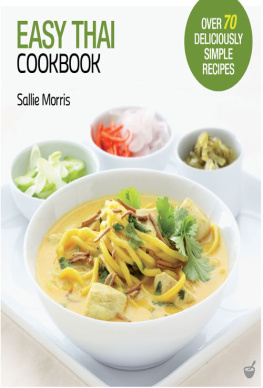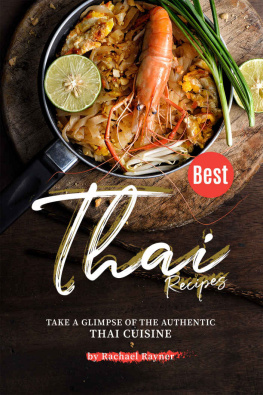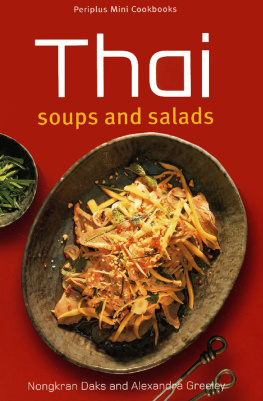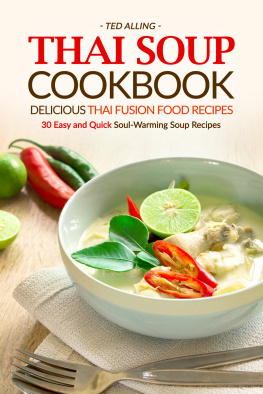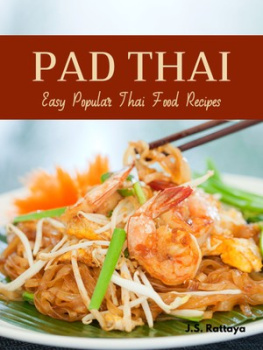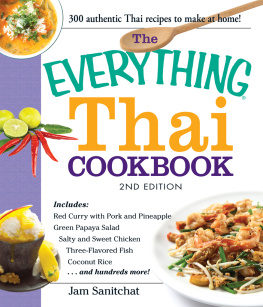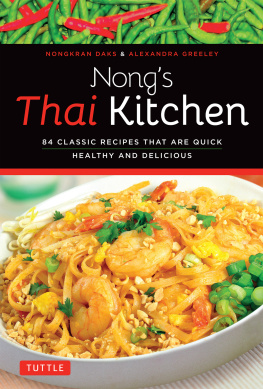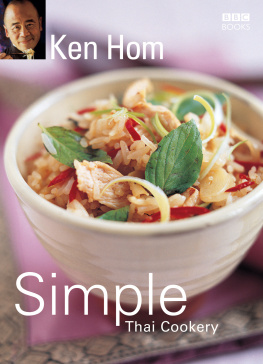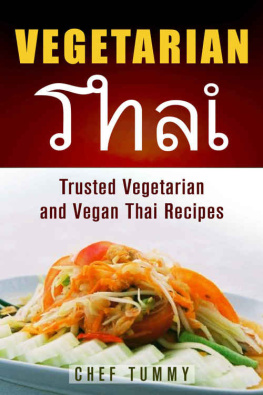EASY THAI
COOKBOOK
Sallie Morris
EASY THAI
COOKBOOK
Sallie Morris
OVER 70 DELICIOUSLY SIMPLE RECIPES
CONTENTS
INTRODUCTION
The popularity of Thai food is borne out by the ever-increasing number of Thai restaurants, as more people recognize the delicious mouth-tingling delights of real Thai cuisine. Originally the Thai (Tai) people were migrants from southwest China who first settled in the north and kept moving southward, setting up capitals with romantic names such as Sukhothai (Dawn of Happiness), Ayutthaya (Unassailable) and then Bangkok (City of Angels) at the end of the eighteenth century. On their move south, they found that the fertile central plains and plentiful rainfall proved perfect for paddy fields of superb quality, which is why the area is known as the rice bowl of Southeast Asia.
Thailand is about the size of France with a population of around 60 million. Myanmar, Laos, Cambodia and Malaysia are its immediate neighbours. With trade between these and other countries of the region, many ingredients are common to each cuisine but are frequently employed in entirely different cooking methods, neatly illustrating the point that food has no borders or boundaries. Though regional cooking exists in Thailand, Thai restaurants will more usually cook and serve the better known dishes that they know their customers will enjoy.
The development of Thai cuisine, with its historical and culinary influences from China, has been a long and subtle process. From Arab and Indian merchants, the Thais adopted the use of dry spices coriander, cumin, nutmeg, cloves and turmeric as used in the Thai Mussaman Curry (see the different flavours are married together that makes Thai food unique. Threads of Indian cuisine are also revealed in the rich tapestry of Thai food. The wet spice pastes bear a strong resemblance to the masalas of southern India, which invariably include the essential three Cs of oriental cookery: coconut, chilli and coriander/cilantro.
The three overriding attractions of Thai food are the tastes, textures and aromas. The tastes include red and green hot birds eye chillies; creamy coconut; coriander/cilantro (roots, stalks and leaves); basil leaves, with their aniseed aroma; heavenly lemon grass; pine-like galangal (kha); torn lime leaves (just smell that citrus fragrance); limes for their juice or as wedges to squeeze over prepared dishes; pungent kapi (fermented shrimp paste), which has no fishy taste but gives depth to dishes in which it is used; and salty, whisky-coloured fish sauce, nam pla - definitely the Thai condiment. The textures are crunchy peanuts and toasted desiccated/dried shredded coconut, crisp green vegetables and unripe fruits for salads such as green mango, meltingly tender deep-fried fish and curried meats, and juicy, simply prepared oriental fruits, such as mangosteens and lychees. As for the aromas, just the fragrance of lemon grass and lime leaves or the aroma of a curry paste being stirred into coconut milk is enough to whet the appetite.
An interest in food is always a joy a never-ending voyage of discovery in which there is always something new around the corner. With the growing popularity of Thai cuisine, the ingredients are increasingly widely available, whether in supermarkets or corner shops, so, with the help of these recipes, you too can cook authentic Thai food.
THE BASICS
Thai cuisine involves ingredients that may be unfamiliar to some cooks, but virtually all of them will be available at large supermarkets, if you are not lucky enough to have an oriental store near you. Bamboo shoots, bean curd, bean sprouts, chillies, coconut, curry pastes, fish sauce and lemon grass all add their exotic flavours to Thai meals. "Rice" and "food" are synonymous in the Thai language, so a good helping of rice is central to the meal, unless noodles are being served.
The only specialist equipment you will need is a wok for stir-fries, though a pestle and mortar are useful for grinding pastes. Thai food is usually barbecued, deep-fried, steamed or stir-fried, all of which are quick methods of cooking, so the food will be ready in no time. Only curries, which need to simmer for a while to develop their flavours, take much time to cook. At the heart of Thai cookery lie the pastes on which so many delicious dishes are based: red and green curry pastes, Mussaman curry paste and Hung Lay curry paste all play an important part in the final flavour, though many have their spicy character subdued by the addition of coconut milk a central ingredient in Thai food. Once you understand the basic ingredients and methods, you are ready to prepare your first Thai meal.
INGREDIENTS
AUBERGINES OR EGGPLANTS
These are also known as brinjal (a name of Indian origin). There are many different types, from the long purple variety to the white/green type, about the size of a pingpong ball, which can be eaten raw with Nam Prik Sauce (see ), or pounded with the ingredients for a sauce or added to curries. The garden pea type can be used in the same way in the sauce or as an addition to a green curry.
BAMBOO SHOOTS
Sliced bamboo shoots are available in cans. Once the can is opened, pour the contents into a container with a lid, cover with fresh water daily and use within a week.
BANANA LEAVES
These giant leaves, used as the Southeast Asian answer to kitchen foil, are available from some oriental supermarkets. Plunge the leaves into boiling water to make them more supple before placing the ingredients that are to be cooked inside and folding the leaf over into a neat parcel. Often you will need a cocktail stick/toothpick or thin satay stick to secure the parcel. Food wrapped in this way is usually grilled/broiled or sometimes steamed, giving the food the added flavour of the banana leaf itself. Apart from the taste, foil is an acceptable alternative. Banana leaves can also be used as plates, as well as being made into cups to hold food during cooking (see for instructions).
BASIL LEAVES
There are three types of basil. Sweet basil (bai horapha) is used widely in curries and some stir-fry dishes. It has dark, glossy leaves with a strong, pungent flavour. Holy basil (bai krapao), so named because it flourishes around pagodas, has longer, narrower and lighter-coloured leaves. It gives off its full flavour, which is hot and spicy, quite like cloves, only when cooked and is much used as an ingredient in stir-fry dishes. Finally, lemon basil (bai mangluk) is popular in the northeastern region of Thailand in soups and salads.
BEAN CURD
Fragile-looking 7.5cm/3in squares of fresh bean curd, or tofu, are sold in the refrigerated section of oriental stores from an open box covered with fresh water. The bean curd is made from soybean milk set with gypsum. In spite of its bland flavour, it is full of protein and used throughout the whole region. It will keep in the refrigerator for three or four days if covered with fresh water daily. A long-life version is also available from supermarkets; once opened use as fresh. Deep-fried bean curd is used in many dishes. Cubes of bean curd, which are deep-fried until golden and packaged for the freezer, are available in 100g/3oz bags from oriental stores. To use from the freezer, pour boiling water over them to thaw, drain after one minute, cool slightly and then squeeze the curd cubes to get rid of any excess oil. The cubes can then be used whole or cut into slices.
Next page
